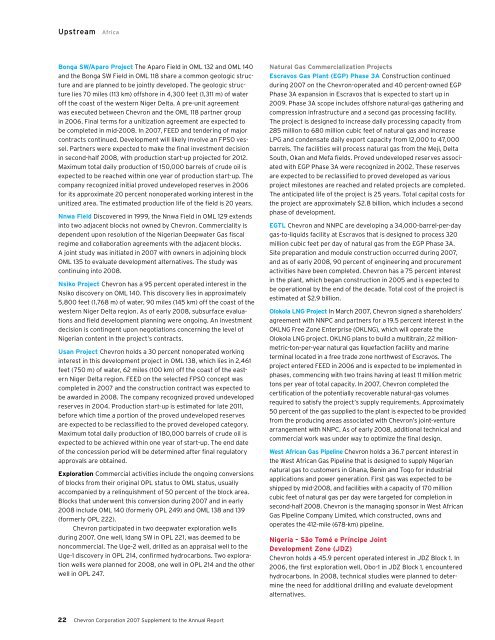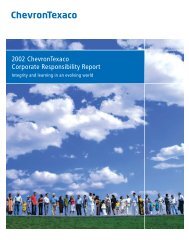Chevron 2007 Annual Report Supplement
Chevron 2007 Annual Report Supplement
Chevron 2007 Annual Report Supplement
Create successful ePaper yourself
Turn your PDF publications into a flip-book with our unique Google optimized e-Paper software.
Upstream Africa<br />
Bonga SW/Aparo Project The Aparo Field in OML 132 and OML 140<br />
and the Bonga SW Field in OML 118 share a common geologic structure<br />
and are planned to be jointly developed. The geologic structure<br />
lies 70 miles (113 km) offshore in 4,300 feet (1,311 m) of water<br />
off the coast of the western Niger Delta. A pre-unit agreement<br />
was executed between <strong>Chevron</strong> and the OML 118 partner group<br />
in 2006. Final terms for a unitization agreement are expected to<br />
be completed in mid-2008. In <strong>2007</strong>, FEED and tendering of major<br />
contracts continued. Development will likely involve an FPSO vessel.<br />
Partners were expected to make the final investment decision<br />
in second-half 2008, with production start-up projected for 2012.<br />
Maximum total daily production of 150,000 barrels of crude oil is<br />
expected to be reached within one year of production start-up. The<br />
company recognized initial proved undeveloped reserves in 2006<br />
for its approximate 20 percent nonoperated working interest in the<br />
unitized area. The estimated production life of the field is 20 years.<br />
Nnwa Field Discovered in 1999, the Nnwa Field in OML 129 extends<br />
into two adjacent blocks not owned by <strong>Chevron</strong>. Commerciality is<br />
dependent upon resolution of the Nigerian Deepwater Gas fiscal<br />
regime and collaboration agreements with the adjacent blocks.<br />
A joint study was initiated in <strong>2007</strong> with owners in adjoining block<br />
OML 135 to evaluate development alternatives. The study was<br />
continuing into 2008.<br />
Nsiko Project <strong>Chevron</strong> has a 95 percent operated interest in the<br />
Nsiko discovery on OML 140. This discovery lies in approximately<br />
5,800 feet (1,768 m) of water, 90 miles (145 km) off the coast of the<br />
western Niger Delta region. As of early 2008, subsurface evaluations<br />
and field development planning were ongoing. An investment<br />
decision is contingent upon negotiations concerning the level of<br />
Nigerian content in the project’s contracts.<br />
Usan Project <strong>Chevron</strong> holds a 30 percent nonoperated working<br />
interest in this development project in OML 138, which lies in 2,461<br />
feet (750 m) of water, 62 miles (100 km) off the coast of the eastern<br />
Niger Delta region. FEED on the selected FPSO concept was<br />
completed in <strong>2007</strong> and the construction contract was expected to<br />
be awarded in 2008. The company recognized proved undeveloped<br />
reserves in 2004. Production start-up is estimated for late 2011,<br />
before which time a portion of the proved undeveloped reserves<br />
are expected to be reclassified to the proved developed category.<br />
Maximum total daily production of 180,000 barrels of crude oil is<br />
expected to be achieved within one year of start-up. The end date<br />
of the concession period will be determined after final regulatory<br />
approvals are obtained.<br />
Exploration Commercial activities include the ongoing conversions<br />
of blocks from their original OPL status to OML status, usually<br />
accompanied by a relinquishment of 50 percent of the block area.<br />
Blocks that underwent this conversion during <strong>2007</strong> and in early<br />
2008 include OML 140 (formerly OPL 249) and OML 138 and 139<br />
(formerly OPL 222).<br />
<strong>Chevron</strong> participated in two deepwater exploration wells<br />
during <strong>2007</strong>. One well, Idang SW in OPL 221, was deemed to be<br />
noncommercial. The Uge-2 well, drilled as an appraisal well to the<br />
Uge-1 discovery in OPL 214, confirmed hydrocarbons. Two exploration<br />
wells were planned for 2008, one well in OPL 214 and the other<br />
well in OPL 247.<br />
<strong>Chevron</strong> Corporation <strong>2007</strong> <strong>Supplement</strong> to the <strong>Annual</strong> <strong>Report</strong><br />
Natural Gas Commercialization Projects<br />
Escravos Gas Plant (EGP) Phase A Construction continued<br />
during <strong>2007</strong> on the <strong>Chevron</strong>-operated and 40 percent-owned EGP<br />
Phase 3A expansion in Escravos that is expected to start up in<br />
2009. Phase 3A scope includes offshore natural-gas gathering and<br />
compression infrastructure and a second gas processing facility.<br />
The project is designed to increase daily processing capacity from<br />
285 million to 680 million cubic feet of natural gas and increase<br />
LPG and condensate daily export capacity from 12,000 to 47,000<br />
barrels. The facilities will process natural gas from the Meji, Delta<br />
South, Okan and Mefa fields. Proved undeveloped reserves associated<br />
with EGP Phase 3A were recognized in 2002. These reserves<br />
are expected to be reclassified to proved developed as various<br />
project milestones are reached and related projects are completed.<br />
The anticipated life of the project is 25 years. Total capital costs for<br />
the project are approximately $2.8 billion, which includes a second<br />
phase of development.<br />
EGTL <strong>Chevron</strong> and NNPC are developing a 34,000-barrel-per-day<br />
gas-to-liquids facility at Escravos that is designed to process 320<br />
million cubic feet per day of natural gas from the EGP Phase 3A.<br />
Site preparation and module construction occurred during <strong>2007</strong>,<br />
and as of early 2008, 90 percent of engineering and procurement<br />
activities have been completed. <strong>Chevron</strong> has a 75 percent interest<br />
in the plant, which began construction in 2005 and is expected to<br />
be operational by the end of the decade. Total cost of the project is<br />
estimated at $2.9 billion.<br />
Olokola LNG Project In March <strong>2007</strong>, <strong>Chevron</strong> signed a shareholders’<br />
agreement with NNPC and partners for a 19.5 percent interest in the<br />
OKLNG Free Zone Enterprise (OKLNG), which will operate the<br />
Olokola LNG project. OKLNG plans to build a multitrain, 22 millionmetric-ton-per-year<br />
natural gas liquefaction facility and marine<br />
terminal located in a free trade zone northwest of Escravos. The<br />
project entered FEED in 2006 and is expected to be implemented in<br />
phases, commencing with two trains having at least 11 million metric<br />
tons per year of total capacity. In <strong>2007</strong>, <strong>Chevron</strong> completed the<br />
certification of the potentially recoverable natural-gas volumes<br />
required to satisfy the project’s supply requirements. Approximately<br />
50 percent of the gas supplied to the plant is expected to be provided<br />
from the producing areas associated with <strong>Chevron</strong>’s joint-venture<br />
arrangement with NNPC. As of early 2008, additional technical and<br />
commercial work was under way to optimize the final design.<br />
West African Gas Pipeline <strong>Chevron</strong> holds a 36.7 percent interest in<br />
the West African Gas Pipeline that is designed to supply Nigerian<br />
natural gas to customers in Ghana, Benin and Togo for industrial<br />
applications and power generation. First gas was expected to be<br />
shipped by mid-2008, and facilities with a capacity of 170 million<br />
cubic feet of natural gas per day were targeted for completion in<br />
second-half 2008. <strong>Chevron</strong> is the managing sponsor in West African<br />
Gas Pipeline Company Limited, which constructed, owns and<br />
operates the 412-mile (678-km) pipeline.<br />
Nigeria – São Tomé e Príncipe Joint<br />
Development Zone (JDZ)<br />
<strong>Chevron</strong> holds a 45.9 percent operated interest in JDZ Block 1. In<br />
2006, the first exploration well, Obo-1 in JDZ Block 1, encountered<br />
hydrocarbons. In 2008, technical studies were planned to determine<br />
the need for additional drilling and evaluate development<br />
alternatives.

















